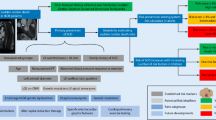Abstract
Background. Patients with hypertrophic cardiomyopathy (HCM) and HCM mutation carriers are at risk of sudden cardiac death (SCD). Both groups should therefore be subject to regular cardiological testing – including risk stratification for SCD – according to international guidelines. We evaluated Dutch cardiologists' knowledge of and adherence to international guidelines on risk stratification and prevention of SCD in mutation carriers with and without manifest HCM.
Methods. A questionnaire was sent to 1109 Dutch cardiologists (in training) containing case-based questions.
Results. The response rate was 21%. Own general knowledge on HCM care was rated as insufficient by 63% of cardiologists. The percentage of correct answers (i.e. in agreement with international guidelines), on the case-based questions ranged from 37 to 96%, being lowest in cases with an unknown number of risk factors for SCD. A substantial portion of correct answers was based on the correct answer ‘ask an expert opinion’. Significantly more correct answers were provided in cases with manifest HCM. There was little difference between the answers of cardiologists with different self-reported levels of knowledge, with different numbers of HCM patients in their practice or with different numbers of carriers without manifest HCM.
Conclusion. Knowledge on risk stratification and preventive therapy was mediocre, and knowledge gaps exist, especially on HCM mutation carriers without manifest disease. Fortunately, experts are frequently asked for their opinion which might bring patient care to an adequate level. Hopefully, our results will stimulate cardiologists to follow developments in this field, thereby increasing quality of care for HCM patients and mutation carriers. (Neth Heart J 2009:17:464–9.).
Similar content being viewed by others
References
Maron BJ, Gardin JM, Flack JM, Gidding SS, Kurosaki TT, Bild DE. Prevalence of hypertrophic cardiomyopathy in a general population of young adults. Echocardiographic analysis of 4111 subjects in the CARDIA Study. Coronary Artery Risk Development in (Young) Adults. Circulation. 1995;92:785–9.
Alcalai R, Seidman JG, Seidman CE. Genetic basis of hypertrophic cardiomyopathy: from bench to the clinics. J Cardiovasc Electrophysiol. 2008;19:104–10.
Elliott P, Andersson B, Arbustini E, et al. Classification of the cardiomyopathies: a position statement from the European Society Of Cardiology Working Group on Myocardial and Pericardial Diseases. Eur Heart J. 2008;29:270–6.
Maron BJ, Towbin JA, Thiene G, et al. Contemporary definitions and classification of the cardiomyopathies: an American Heart Association Scientific Statement from the Council on Clinical Cardiology, Heart Failure and Transplantation Committee; Quality of Care and Outcomes Research and Functional Genomics and Translational Biology Interdisciplinary Working Groups; and Council on Epidemiology and Prevention. Circulation. 2006;113:1807–16.
Elliott P, McKenna WJ. Hypertrophic cardiomyopathy. Lancet. 2004;363:1881–91.
Elliott PM, Gimeno JR, Thaman R, et al. Historical trends in reported survival rates in patients with hypertrophic cardiomyopathy. Heart. 2006;92:785–91.
Maron BJ, Olivotto I, Spirito P, et al. Epidemiology of hypertrophic cardiomyopathy-related death: revisited in a large nonreferral-based patient population. Circulation. 2000;102:858–64.
Miller MA, Gomes JA, Fuster V. Risk stratification of sudden cardiac death in hypertrophic cardiomyopathy. Nat Clin Pract Cardiovasc Med. 2007;4:667–76.
Maron BJ, McKenna WJ, Danielson GK, et al. American College of Cardiology/European Society of Cardiology clinical expert consensus document on hypertrophic cardiomyopathy. A report of the American College of Cardiology Foundation Task Force on Clinical Expert Consensus Documents and the European Society of Cardiology Committee for Practice Guidelines. J Am Coll Cardiol. 2003;42:1687–713.
Elliott PM, Poloniecki J, Dickie S, et al. Sudden death in hypertrophic cardiomyopathy: identification of high risk patients. J Am Coll Cardiol. 2000;36:2212–8.
Epstein AE, Dimarco JP, Ellenbogen KA, et al. ACC/AHA/HRS 2008 Guidelines for Device-Based Therapy of Cardiac Rhythm Abnormalities: Executive Summary. A Report of the American College of Cardiology/American Heart Association Task Force on Practice Guidelines (Writing Committee to Revise the ACC/AHA/NASPE 2002 Guideline Update for Implantation of Cardiac Pacemakers and Antiarrhythmia Devices). Circulation. 2008;117:e350–408.
Zipes DP, Camm AJ, Borggrefe M, et al. ACC/AHA/ESC 2006 Guidelines for Management of Patients With Ventricular Arrhythmias and the Prevention of Sudden Cardiac Death: a report of the American College of Cardiology/American Heart Association Task Force and the European Society of Cardiology Committee for Practice Guidelines (writing committee to develop Guidelines for Management of Patients With Ventricular Arrhythmias and the Prevention of Sudden Cardiac Death): developed in collaboration with the European Heart Rhythm Association and the Heart Rhythm Society. Circulation. 2006;114:e385–e484.
McKenna WJ, Spirito P, Desnos M, Dubourg O, Komajda M. Experience from clinical genetics in hypertrophic cardiomyopathy: proposal for new diagnostic criteria in adult members of affected families. Heart. 1997;77:130–2.
Niimura H, Bachinski LL, Sangwatanaroj S, et al. Mutations in the gene for cardiac myosin-binding protein C and late-onset familial hypertrophic cardiomyopathy. N Engl J Med. 1998;338:1248–57.
van Langen I, Birnie E, Leschot NJ, Bonsel GJ, Wilde AA. Genetic knowledge and counselling skills of Dutch cardiologists: sufficient for the genomics era? Eur Heart J. 2003;24:560–6.
Remme WJ, McMurray JJ, Hobbs FD, et al. Awareness and perception of heart failure among European cardiologists, internists, geriatricians, and primary care physicians. Eur Heart J. 2008;29:1739–52.
Southwell C, Moallem M, Auckley D. Cardiologist's knowledge and attitudes about obstructive sleep apnea: a survey study. Sleep Breath. 2008;12:295–302.
Author information
Authors and Affiliations
Corresponding author
Additional information
Department of Cardiology, Academic Medical Center, Amsterdam, the Netherlands
Department of Cardiology and Department of Clinical Genetics, Academic Medical Center, Amsterdam, the Netherlands
Department of Clinical Genetics, Academic Medical Center, Amsterdam, the Netherlands
Institute of Health Policy and Management, Erasmus Medical Center, Rotterdam, the Netherlands
Department of Medical Psychology, Academic Medical Center, Amsterdam, the Netherlands
I. Christiaans Department of Clinical Genetics, Academic Medical Center, PO Box 22660, 1100 DD Amsterdam, the Netherlands
Rights and permissions
About this article
Cite this article
Vehmeijer, J.T., Christiaans, I., van Langen, I.M. et al. Risk stratification for sudden cardiac death in hypertrophic cardiomyopathy: Dutch cardiologists and the care of mutation carriers. NHJL 17, 464–469 (2009). https://doi.org/10.1007/BF03086305
Issue Date:
DOI: https://doi.org/10.1007/BF03086305




